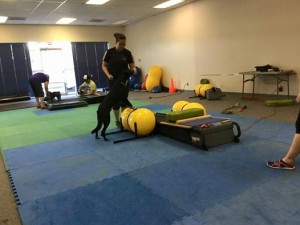As seen in the agility video, some obstacles pose safety risks. Advocates for changes in agility equipment argue the non-breakaway tires, closed fabric chutes, the heights of the A-Frame and dogwalk and the presence of slats on contact equipment pose increased risk for injury.
Common injuries seen in agility dogs (Zinc, 2008):
- Back strains and sprains
- From dog walk slips and weave pole over use
- Torn or ruptured cranial cruciate ligaments
- Slips on the dog walk, incorrect judgement of take-off point at jumps
- Toe or Carpal Arthritis
- Repeated injury to the superficial flexor tendon from stopping on slatted contact equipment
- Biceps tendinitis
- A result of chronic overuse of shoulder muscles from heeling, weave poles
- Iliopsoas strain
- Poor conformation, incorrect jump form
- Medial Shoulder Instability (Edge-Huges, n.d.)
In recent years, awareness has be brought to the importance of canine fitness and the prevalence of injury during training or competition (Kerr et. al., 2014). Often, novice agility classes do not include fitness related activities and go straight into obstacle introduction. Dogs bodies require immense physical strength to perform the obstacles correctly. Consider the weave poles, there there is a incredible need for spinal flexibility and strength. There are now various rehabilitation and conditioning programs that offer certification to instructors, veterinary technicians and veterinarians, to be able to provide proper services and information to owners. This influx of information regarding canine fitness has lead to the creation of companies manufacturing conditioning equipment to allow owners to easily add these activities to their training regimens.
Once dogs get to a competing level, cardiovascular strength is important. Often, dogs are required to perform 3-4 runs in a day and many trials are held in the summer months. Cardiovascular training programs are often included in training schedules. This could be a range of activities including swimming, running, or even playing fetch.
Now that many are considering competition dogs as athletes, there is now a focus on providing dogs proper warm-ups before training and competition. Warm-ups may include a period of walking/trotting, dynamic stretches in the form of tricks, static stretches, and performance of behaviours that may be required during the run such as turns over jumps.

In a nutshell, obstacle training and sequencing should not be the only exercise a competition dog gets. Failing to recognize this, may result in the dogs developing musculoskeletal conditions and discomfort.